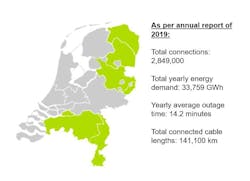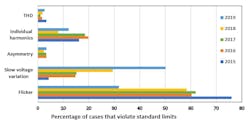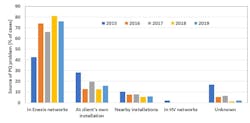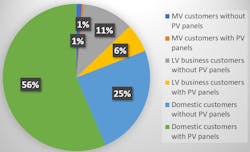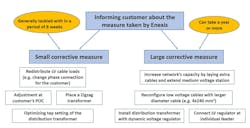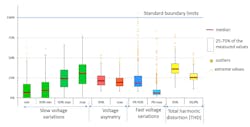To promote the sustainable-energy transition, an increasing number of photovoltaic rooftop panels and wind turbines are being connected to low-voltage and medium-voltage networks. The integration of these renewable sources of generation has changed the existing distribution network configuration into being a more decentralized grid, introducing voltage quality problems on the network. At the same time, the need for electrical energy continues to increase because of the demands imposed by charging electric vehicles (EVs) and heating loads such as heat pumps.
Additionally, over the last two decades, residential customers have been using more electronic appliances that require a pure sinusoidal voltage waveform for trouble-free operation, but they have a negative impact on voltage quality because of the injection of distorted currents at the point of connection (POC). Therefore, maintaining voltage quality in compliance with regulatory standards can be a big challenge for distribution system operators (DSOs).
Enexis Netbeheer B.V. is the second largest DSO in the Netherlands, supplying electricity to more than 2.8 million customers in the northern and southern parts of the country. Over the last five years, the utility has invested in a comprehensive power quality measurement (PQM) program to monitor voltage variations, voltage flicker and harmonics to fully understand the actual power quality (PQ) performance on its high-voltage (HV), medium-voltage (MV) and low-voltage (LV) networks. As part of this program, for the POCs of approximately 1000 customers—less than 0.04% of its customer base—who have complained, Enexis monitors and measures the actual supply voltage quality to ensure the parameters comply with European Standard EN 50160 and Dutch Grid Code. When needed, it takes appropriate remedial measures to restore voltage quality at a POC.
Voltage Quality
Enexis’ reliability of supply has been relatively high over the last few years. In 2019, its system average interruption duration index (SAIDI) was 14.2 minutes compared to the national average of 19.8 minutes. The customer complaints received have been more frequently linked to various supply voltage issues. These customers may have problems because of overvoltage or undervoltage issues, improper functioning of or damage to installed appliances, frequent blowing of lamps and fuses. Other voltage-related complaints have included unwanted tripping of the inverter systems in the photovoltaic (PV) rooftop panels and a flicker experienced on dimmer-controlled lamps.
When a customer makes a voltage complaint, an Enexis engineer analyzes the problem and discusses the complaint in more detail with the customer, if necessary. In many cases, PQ measurement equipment must be installed at the customer’s POC for a short duration or week-long period. In practice, over the last five years, only 20% to 25% of the voltage quality measurements collected have violated the European Standard EN 50160 and Dutch Grid Code boundary conditions. The Dutch standard specifies similar limit values as those in EN 50160 (95% of the time) for the PQ parameters. However, the Dutch Grid Code specifies much stricter limits for voltage flicker and harmonics (100% and 99.9% of the time, respectively).
PQM Analysis
Based on the Enexis database statistics for the five-year period of 2015-2019, it is evident the DSO’s main PQ problems are because of light flickering and voltage variations. Customers located in rural areas often are connected to long isolated networks remote from the source transformer substation. These customers suffer mainly from low voltage and light flicker problems. On the contrary, customers located in cities mainly complain about the occasional high voltage (on sunny days) at their POCs, especially when many customers in the same neighborhood have rooftop PV panel installation.
From the measurements recorded, Enexis has identified specific harmonics (such as the odd triplen harmonic values of the 15th and 21st order) violate the standard boundary limits at some of the customers’ POCs. Also, because single-phase services are not evenly jointed to the three-phase underground LV cable, the load distribution between the three phases is unbalanced, causing voltage asymmetry in the network. In general, Enexis’ complaints can be allocated as follows:
l 50% light flicker problems
l 30% voltage variations
l 20% individual harmonics, total harmonic distortion (THD) for voltage and asymmetry issues.
PQ problems often are complex in nature. It is not always easy to find the origin of a problem because of the interactive behavior. Customers’ electronic equipment injects nonlinear currents into the network that may adversely affect the sinusoidal waveform of the supply voltage. In turn, this distorted voltage waveform can cause a more negative impact on a customer’s appliances.
Based on analysis, Enexis found 75% of PQ problems originate in the underground LV cables because of short circuits from excavation activities. Around 15% of PQ problems are at the customer’s own installation. Another 8% of the problems originate from a nearby neighbor’s installation. The source of the problems for the remaining 2% of the complaints cannot be accurately identified.
Enexis also pinpointed most of the complaints come from residential customers. Small business customers (for example, agricultural businesses) are the second largest group to submit complaints. Also, the DSO noticed the number of complaints from customers who have rooftop PV installations has been increasing annually.
Mitigation Approaches
Enexis only conducts PQM at the customer’s POC after verifying the complaint is justified. Following the PQM, the data is analyzed to identify the type of PQ problem and the probable source. Sometimes, network analysis (using a simulation tool) also is performed to understand the problem before deciding on a proper mitigation action. This generally requires consultation with the asset management team.
Depending on the results of the analysis, a decision is made on what corrective measure to take. A small corrective measure may include reconfiguring an existing section of the network or making an adjustment at the customer’s installation. A larger corrective measure may require network reinforcement, such as adding an extra cable or installing an adjustable LV regulator in a feeder, to solve the voltage quality problem.
During the PQM, network impedance also is measured at the customer’s POC to ensure it is reasonably low compared to the reference impedance value of 283 mΩ for the LV network, as specified in Enexis’ planning guideline. The current European standard does not include sufficient information on the maximum value of network impedance for connections with different capacity installations in the LV grid.
When a PQ complaint is received from a customer with rooftop PV panels, Enexis often recommends the customer first consult with the installation company, as it is often observed the customer’s PV inverter setting and installation do not fully comply with the relevant standard guidelines. When a number of customers with rooftop PV installations residing in the same neighborhood complain about a specific PQ problem (for example, high voltage at their POCs), Enexis can take appropriate corrective measures at the neighborhood level by adjusting the off-load tap-setting on the MV/LV transformer in the source substation. Alternatively, a regulating transformer with a dynamic voltage regulator can be installed when all the outgoing feeders from the transformer substation have homogeneous load distributions.
The same corrective action can be applied when numerous customers opt to charge their EVs simultaneously during the peak evening hours, which results in overloading and undervoltage on the LV feeder. A smart charging approach also can be adopted for EV customers to restrict the overloading of the LV feeder and maintain the supply voltage within the standard limits.
When the outgoing LV feeders from a transformer substation are of heterogeneous type with different types of connected customers, a LV voltage regulator can be installed at an individual customer’s POC or at a LV feeder terminal to solve voltage variation problems.
National PQM Program
The Dutch regulator Autoriteit Consument & Markt (ACM) requested all DSOs in the Netherlands conduct PQ monitoring on their networks to provide an improved understanding of the present voltage quality of the Dutch grids. Voltage quality parameters are monitored at all voltage levels at locations approved by the regulator. The results are published on a national website, thereby maximizing the transparency of utility services.
Enexis conducts continuous voltage monitoring at 58 MV/LV substations. Most of the Dutch DSOs also participate in this continuous voltage monitoring program on their own networks. All these measurements help the national standardization committee to develop an appropriate and realistic standard on voltage dips that can be applied throughout the Netherlands. Furthermore, continuous monitoring is installed at all the extra-high-voltage (EHV) and HV customers’ terminals and at all significant connection points on the network.
In addition, Enexis and the other DSOs in the Netherlands participate nationally in the PQM campaign to monitor their MV and LV networks, whereby 500 network points are monitored annually, each location for one week. This is conducted to access the current voltage quality status of the Dutch grids.
In the MV grids, only a few incidents of voltage parameter violations have been recorded in previous monitoring campaigns. It is mainly the LV networks where the 15th harmonic voltage values often exceed the boundary limits of the EN 50160 standard, a trend that also is common in Europe. Recently, the 15th and 21st harmonic voltage limit values for LV networks have been increased by the European Standardization Committee. Now, in accordance with the EN 50160/A3 (2019) standard, the present limit is 1% for the15th harmonic voltage and 0.75% for the 21st harmonic voltage. These stricter revisions for permitted harmonic levels will effectively reduce the number of violation incidents recorded in the national PQM reports.
Reduced Violations
Enexis has been highly proactive with PQM activities at all voltage levels on its distribution network. The results indicate 50% of the PQ complaints on its distribution network are linked to light flicker, 30% to voltage variations, and 20% to harmonics and asymmetry issues. It also is evident in recent years the number of complaints from customers with rooftop PV panels has been increasing. They sometimes experience a power outage because of the unwanted tripping of their PV inverter system, stemming from the overvoltage sensor. When many customers in the same neighborhood experience a similar PQ problem, the DSO is obliged to take the necessary corrective measures to improve customer service.
Enexis has participated in the national PQM program to monitor its networks since the program launched. Overall, the results of the national monitoring campaign confirm the voltage quality of the Dutch networks is reasonably good except for some local flicker and harmonics issues. Adaptation of the new EN 50160/A3 standard guidelines for the 15th and 21st harmonics should reduce the number of violations in the future.
Sharmistha Bhattacharyya ([email protected]) holds a Ph.D. degree in electrical engineering from Eindhoven Technical University in the Netherlands. She has several years of experience in power system consultancy and utility asset management. In 2016, she was appointed a senior consultant at Enexis Netbeheer B.V., where she employs her expertise on power quality issues in the distribution network. Bhattacharyya also is involved in various smart grid projects in the Netherlands.
About the Author
Sharmistha Bhattacharyya
Sharmistha Bhattacharyya holds a Ph.D. degree in electrical engineering from the Eindhoven University of Technology. She has several years of experience in power system consultancy and utility asset management. Since 2016, she has worked for Enexis Netbeheer B.V. as a senior consultant. Bhattacharyya has expertise on power quality issues in the electrical network and is involved in various other smart grid projects in the Netherlands.


